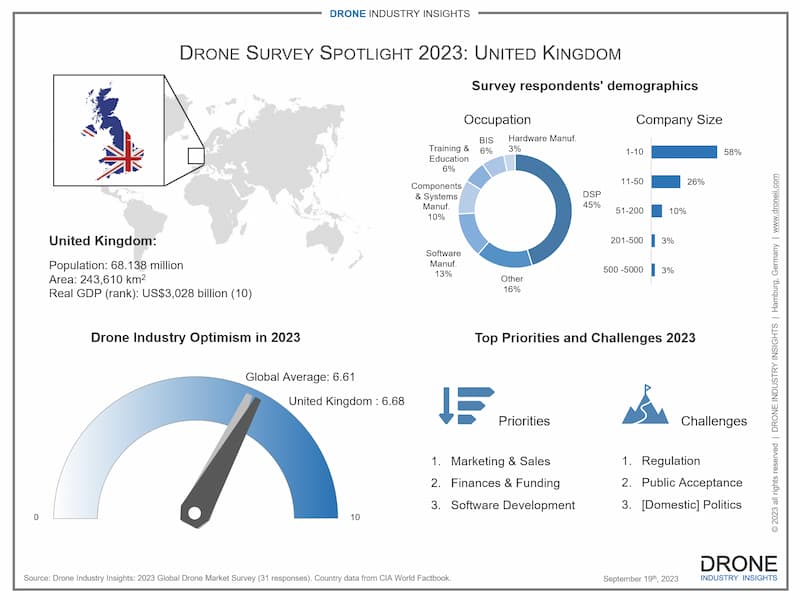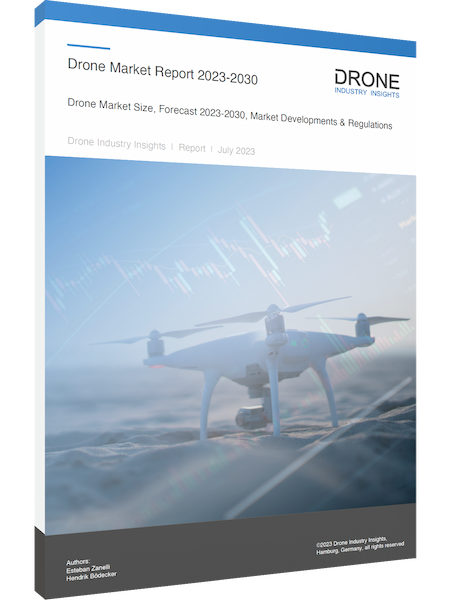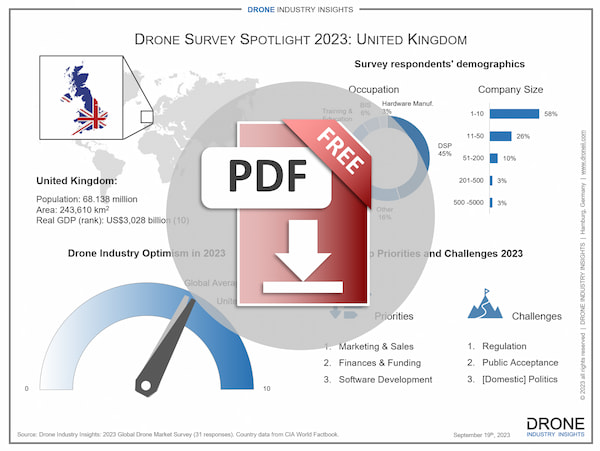Survey Snapshot: The UK Drone Market
Note: The following information about drone companies in the UK is based exclusively on data from our latest drone industry survey and is not a comprehensive drone market study. Therefore, it should be interpreted as a glimpse into the United Kingdom’s drone market rather than in-depth authoritative research. For a more thorough study, please contact info@droneii.com
Shifting our attention to one of the top 10 global economies in terms of real GDP, we continue our country series with the UK Drone Market. With one of the strongest currencies in the world and global influence in various fields, there is a lot of potential for drone technology, and that is why the UK already ranks among the top drone markets. Most recently, it was announced that the Royal Mail launched its first permanent postal drone delivery service in Scotland. So the long-awaited service of drone deliveries is very much already a reality within some industries in the UK drone market.
Opportunity for Drones in the UK
With a population of 68.138 million and an area of 243,610 km2, the United Kingdom offers a unique opportunity for the drone industry. Despite its relatively small size, the UK boasts a robust economy, with a real GDP of $3,028 billion (ranked 10th globally). While the country’s agricultural sector is limited, the majority of its GDP (79.2%) comes from services, including industries such as railroad equipment, shipbuilding, aircraft, coal, and petroleum. All of these are industries where drones have been proven to enhance workflow.
In recent years, the UK has also witnessed significant advancements in the use of drones. This is particularly the case in healthcare and delivery, where in 2021 there were headlines about BVLOS autonomous deliveries of COVID tests and protective equipment (PPE) and 2022 saw the blueprint for a 265km (165-mile) drone superhighway, as well as drone use by the Royal Mail and the NHS. All of this paints a promising picture and solid potential for the future of UK drones.
* All country data from the CIA World Factbook
UK Drone Market Composition
The UK drone market is primarily composed of small companies, with 84% of them having fewer than 50 employees. While the majority of these companies (45%) are Drone Service Providers (DSPs), there is also a significant presence of software manufacturers (13%), and components and systems manufacturers (10%). Here, is it also worth mentioning that the category officially labeled as “Other” in the infographic includes several consulting companies.
Further common types of UK drone companies include activities such as drone training/education providers or businesses that only use drones internally (BIS). Moreover, approximately two-thirds of UK drone companies are members of a drone association, indicating a sense of community and collaboration within the industry. In this regard, many drone operators and drone companies in the UK are likely familiar with the work of ARPAS-UK.
Interested in the Commercial Drone Market? Check Out Our Latest Drone Market Report!
Drone Market Report 2023
• 227-page drone market report featuring:
• Commercial drone market + recreational drone market
• Breakdown of data by: segment, industry, method, region, and country
• Additional chapters on regulation and rising technology trends
Priorities and Challenges for Drone Companies in the UK
Much like in many other parts of the world, marketing & sales have become the top priority for UK drone companies. This is followed by finances & funding, and software development, both of which speak to key aspects of the UK drone market composition: the large number of small companies/startups require funding to scale their business, and given the high number of drone software companies in the UK drone market, software development is of course ranked as a high market priority overall.
Drone companies in the UK also face several challenges common to the rest of the world, including regulation. Participants in the 2023 drone industry survey specifically mentioned legislative hurdles and slow processing as obstacles for BVLOS applications, which are key for the industry to thrive. The second and third primary challenges for the UK drone market were public acceptance, and domestic politics. In this regard, participants expressed a lack of awareness about the extent to which drones deliver operational and financial benefits. However, the aforementioned headlines from the Royal Mail and NHS will hopefully help build more awareness about the unparalleled advantages of using drone technology.
UK Drones: The Paradox of UK Drone Regulation
The UK drone industry is more optimistic about the future this year compared to the previous year, with a rating of 6.6 out of 10 (versus 5.9 in 2022). This optimism is in line with the global average, which stands at 6.68. Moreover, in terms of the top market-driving factors, drone companies in the UK considered these to be 1. Rule-making authorities, 2. DSPs, and 3. Software manufacturers. However, respondents also stated that they didn’t see significant regulatory changes and this brings us to the paradox of UK drone regulation.
After 2022, the UK was ranked a the top of the regulatory Drone Readiness Index alongside Australia. This ranking would likely not sit so well with the UK drone companies who see regulation as a challenge and are eager to do more. However, it is worth noting that the ranking focuses on the creation/availability of regulatory frameworks themselves rather than on the speed at which permits are acquired or exceptions are given. So there seems to be a paradox in UK drone regulation where plenty of work is being done to establish necessary frameworks but drone operators believe that a lot of work is needed regarding the regulatory process to get advanced operations off the ground.
In conclusion, the United Kingdom’s population, area, and economic landscape make it an ideal environment for the drone industry to thrive. By leveraging its strengths in services and various industries, the UK can continue to explore the potential of drones in areas such as healthcare, transportation, and infrastructure. However, to fully realize this opportunity, the industry must address challenges related to regulation, public acceptance, and domestic politics, while also fostering collaboration and innovation among its diverse range of stakeholders.
Stay tuned as we continue to feature more countries and regions with unique and exclusive data from our annual Drone Industry Survey. If you are interested in learning more about the global drone market, you can find detailed data by sector, industry, method, region, and country in our flagship Drone Market Report.
And if you are interested in all the ins and outs of a particular region or country, including information on individual companies, you can contact us to discuss a comprehensive drone market study. Please contact info@droneii.com with the subject “Customized Drone Market Research”.
Download our FREE Drone Companies in the UK Infographic
Our Infographic about drone companies in the UK shows a market breakdown of what drone companies do, their size, top priorities and challenges. It also features an optimism meter comparing drones in the UK with the rest of the world.

Before working with drones, Ed acquired vast experience in Communications and Diplomacy. He holds a Master’s in International Relations, Bachelor’s in Economics & Philosophy, and has lived in 7 countries.





